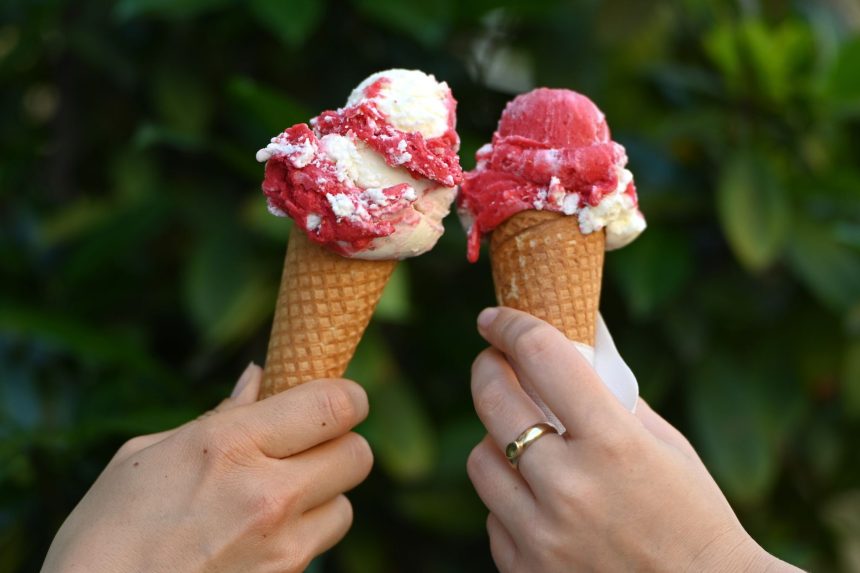With temperatures in many places in Germany expected to approach 30 degrees Celsius this weekend, there’s really only one solution: head to the nearest ice cream parlour.
But while prices for a scoop of the cold delight might not make you boiling mad, they might make you at least a little bit annoyed, according to a YouGov survey commissioned by dpa and published on Saturday.
Nearly two-thirds (64%) of people in Germany believe ice cream prices are too high, a survey of around 2,000 people aged 18 and older showed.
Six out of 10 respondents said they “always” or “occasionally” order fewer scoops due to the increased prices compared to five years ago. For 28%, however, the price has no impact on the number of scoops they buy. Most people purchase two scoops (50%) or three scoops (23%).
Scoops cost €1.30 ($1.52) to €2.80
In some regions of Germany, ice cream has become more expensive compared to last year. “Some ice cream parlours have raised their prices,” said Annalisa Carnio, spokeswoman for the Association of Italian Ice Cream Manufacturers in Germany (Uniteis).
However, overall, the price level has remained relatively stable as inflation, like in other food sectors, has eased.
And ice cream aficionados rarely complain, Carnio said.
“Customers know that everything has become more expensive. Some grumble, but they are a minority,” she explained.
Uniteis represents the interests of 900 members with around 2,000 ice cream parlours that produce their own ice cream. The total number of ice cream parlours in Germany is higher. According to the Hotel and Restaurant Association (Dehoga), there were around 5,000 in 2023.
The price of a scoop varies a lot, Carnio said. In a café with a large terrace and extensive staff in the centre of a major city, it is more expensive than in a small parlour in the countryside. Prices range from €1.30 in rural areas to €2.80 in cities like Hamburg or Munich. Last year, prices were at a similar level or slightly lower.
Prices in Germany’s European neighbours higher
If it’s any consolation, ice cream in Germany is relatively inexpensive, said Uniteis spokeswoman Carnio. In France, a scoop costs between €3.50 and €5, in Italy €2.50 to €4, and in Spain €3 to €4. According to a survey by the site coupons.de, prices in Switzerland exceed €5 per scoop.
According coupons.de, of 176 ice cream parlours in 60 German cities, the average price of a scoop in spring was €1.81. The most expensive locations were holiday destinations like Sylt and St Peter-Ording, with prices up to €2.50. Cheaper options were found in Halle and Dortmund, where prices were below €1.50. For comparison, the average price for a scoop was €1.72 a year ago and €1.62 in 2023.
Unclear if ice cream eaters eat less
Market researcher NIQ has no sales data on whether people are consuming fewer scoops, but Italian ice cream manufacturers have observed changes in consumption behaviour but no decline in demand.
“Ice cream fascinates people,” said consumer psychologist Jens Lönneker, noting a similar effect to chocolate.
“It’s sweet indulgence provides a comforting contrast to the harsh realities of life. Its coldness soothes the heat. But the ultimate magic is in the experience of it melting,” said the founder of the Rheingold Salon in Cologne. Lönneker said he did not think price increases will have a lasting impact on demand.
Chocolate still favourite flavour
Like many in the hospitality industry, ice cream parlours face challenges, with costs rising for staff, energy, rent, and ingredients such as milk, cream, and fruit.
Persistent staff shortages and the minimum wage are particularly burdensome, according to the association. Additionally, the prices of coffee and cocoa have risen steeply in recent years.
In Germany, chocolate remains the most popular ice cream flavour, the YouGov survey showed, followed by vanilla and stracciatella, which is chocolate chip.
In recent years, some gelaterias have introduced higher prices for premium flavours and special creations, including pistachio, which has become more expensive due to rising ingredient costs.
What ‘should’ a scoop cost?
Six out of 10 survey respondents in Germany consider a price between €1 and €1.50 reasonable, while 28% think prices between €1.50 and €2 are okay. Only 6% think it should cost more.
Source: dpa


















